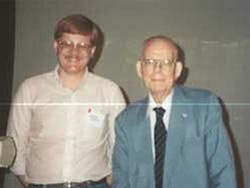Want to Achieve Real Improvement? Stop Blaming the People!
“A bad system will beat a good person every time.” Dr. W. Edwards Deming
One of my favorite quotes from Dr. Deming is, “A bad system will beat a good person every time.” This is one of the many lessons to be learned from Dr. Deming’s Red Bead Experiment. I had the opportunity to see Dr. Deming do his experiment twice. The second time I tried to capture every word he said because I knew that someday I would incorporate this activity into my own training classes.
Here’s a quick recap of the Red Bead Experiment: Dr. Deming would first ask for volunteers to fill six “willing worker” positions. He then told these workers to dip a paddle with 50 indentations into a bowl of beads that were about 20% red and 80% white. The red beads represented defects and, as the boss, he made it clear that red beads were unacceptable. Of course, statistically speaking, it was nearly impossible to pull out the 50 random beads without a few of them being red. Each time this happened, Dr. Deming would say something like, “I am very disappointed with your work. You do want a job, don’t you? Maybe you should try a little harder next time!”
It was Jim Brown’s first day on the job, and to say he was nervous was the understatement of the year. Just a few weeks prior, Jim had been walking across a stage to accept his college diploma. Soon after, he found out that he had been accepted into a Fortune 10 management training program that consisted of four six-month assignments in various manufacturing leadership positions. His first assignment was at a small midwestern plant.
After going through all of the required paperwork and orientation, Jim’s new boss stopped by to introduce himself. “Your first assignment will be working for me and overseeing the final inspection quality lab,” he shared. “You have five quality inspectors working for you, and they are responsible for testing 100% of the product before it goes out the door. Four do visual and functional tests, and the fifth does a ‘high pot’ test.”
“High pot test… What is that?” asked Jim.
“We wire the product to a device that overloads the unit with power to make sure it can withstand any electrical jolts it may encounter out in the field. This is one of the requirements given to us by our customers.”
Read more continuous improvement articles from John Dyer.
After Jim’s boss left, another man stopped by and introduced himself as Kyle, the head of the maintenance department. “I overheard what your first assignment will be, and I wanted to give you fair warning about one of your employees. The guy who does the ‘high pot’ test is a real character. His name is McGreggor, and he is a mean, grumpy, no good, piece of…” Kyle caught himself and said, “Well, you get the idea. No one wants to work with this toxic employee. In fact, we had to build him a separate, private room to do the final tests just so he wouldn’t interact with any of our other employees.”
“If he is that bad, why does he still work here?” asked Jim.
“He has been written up multiple times for missing his output goals. One more and he will finally meet the criteria for being fired. A piece of advice,” Kyle continued. “I would stay away from him as much as possible. Maybe wait a few weeks and get your feet on the ground before enduring your first confrontation.”
After Kyle left, Jim thought about what he had said. “Is avoiding a problem and letting it fester better than confronting it head on? I don’t think that is the wise approach.” With that, Jim got his safety glasses and headed out to the high pot test room.
“Who is disturbing my work?” McGreggor spat out when he heard the door to his room open. “If I miss my test goals for the day, I now know who to blame!”
“Hello… um… Mr. McGreggor,” Jim nervously stammered. “I am your new leader and wanted to introduce myself.”
McGreggor paused what he was doing and looked Jim over before saying, “You? You are my new boss? Ha! That’s a laugh. What baby crib did you crawl out of? You can’t possibly be more than 10 years old. And you are my boss? Look, I know how these six-month assignments go. Just leave me alone and in six months, I will give you a decent review so you can get a nice promotion.” With that said, McGreggor returned to his work.
“Look, I know I am new and I have a lot to learn,” Jim replied. Maybe you could teach me a few things about how to be a quality inspector.” McGreggor continued to load the test equipment. After a brief, silent pause, Jim continued, “I am hoping to do something over these next six months to help you improve the way things are done around here.”
McGreggor stopped what he was doing and stood up. His 6-foot, 2-inch body towered over Jim, and the scowl on his face made it clear that he was not happy. “You, help me?! I have been doing this job longer than you have been breathing, and you think that there is something that you can do to help me? You’re just a snot-nosed kid trying to make a name for himself. Now, I am only going to ask this once. Will you turn around and go out the way you came in, and go bother someone else with your nonsense and leave me alone?”
“All right,” said Jim. “I will let you get back to work. Have a great day, and I will be sure to stop by again tomorrow to see what I can do to help.” Jim left the room and McGreggor let out a long sigh and shook his head. “Another kid to break. Why do they keep hiring these know-nothing academics?”
For the next several days at precisely 9 a.m., Jim would stop by the high pot test room and ask McGreggor if there was anything he could do to help. Each time, his question was met with stone cold silence. On the 10th day, it became clear that Jim was not going to leave McGreggor alone.
“Good morning, Mr. McGreggor,” Jim said on that 10th day. “I hope you are doing well. Please let me know if there is anything I can do to help you with your job today.”
Instead of his usual silence, McGreggor paused what he was doing and said, “You’re not going to stop, are you?” Jim smiled at him and shook his head no. “All right. There is something you can do to help. See those lights above my workbench? Two of the four bulbs haven’t worked for a long time, and it makes it hard to read all of the test requirements. You get that light to work, and we can talk some more. But until you get that fixed, don’t bother me any further.”
Jim agreed, got some information off the light fixture and left. McGreggor smiled to himself for the first time in a long while. “He’ll never get that fixed,” he thought. “No one else has been successful. I can now get my work done in peace, and I probably won’t see Jim Brown in here again.”
Jim soon realized that fixing the light was not going to be an easy endeavor. The bulbs were not standard issue, and they were not carried in the supply crib. He began to call various light dealers and finally found one on the other side of town that had the bulbs Jim required. On his lunch break, Jim drove over and paid for the bulbs out of his own pocket. When he returned, Jim found Kyle, the head of maintenance, and asked for his help.
“Where did you get the bulbs?” Kyle asked.
“I found them at a supply store across town,” said Jim.
“Hmm. that is not one of our certified suppliers. We can’t install anything that did not go through all of the proper channels and get the dozen signatures required to approve the purchase,” said Kyle.
“Look, these bulbs are exact matches in every way, and I paid for them myself. If they are not installed, then I guess I will need to write up the high pot test room as an unsafe place to work due to poor lighting and shut it down. We both know what kind of headaches that will cause and all of the paperwork that will generate. Are you sure we can’t use them?”
“Will you make certain McGreggor is not in the room?” asked Kyle. After Jim nodded, Kyle reluctantly agreed to get a ladder and install the bulbs himself after everyone went home.
The next morning Jim was waiting for McGreggor when he arrived to start his shift. When the light switch was flipped, it was quickly apparent that the brightness had doubled.
“I guess you want some sort of gold star,” McGreggor said. “That task clearly wasn’t tough enough to keep you away. Look, we both know that I am one bad production day away from being fired. Why don’t you just leave me alone instead of trying to gather information for my replacement?”
“Or maybe we could work together to try and figure out how to make the process better so you can keep your job,” replied Jim.
“I’m not sure that I want to keep working here,” said McGreggor with a solemn tone to his voice. “After forcing thousands of thick copper wires into 1950s-era clamps all day, I have to soak my wrists for an hour when I get home to reduce the throbbing pain. And I am quite sure that no one can consistently keep up with the daily production goals using this piece of junk test equipment.”
Jim left the test lab more determined than ever to help McGreggor. He contacted the original manufacturer of the test machine and discovered that there had been many updates to both the hardware and software that could be applied for a few thousand dollars. Jim explained to his boss and the plant manager that these upgrades would not only help increase productivity and make the tests more accurate, but they would also address a major ergonomic issue. After much discussion, the leaders gave Jim the green light.
Jim walked McGreggor through the upgrade options and got his input. “Can the new clamps be installed in this configuration?” asked McGreggor. “That would help the loading and unloading process.”
“I don’t see why not,” replied Jim. You sketch up how you want them, and I will make sure the maintenance folks follow your diagram when the new parts come in. By the way, have you thought about changing the sequence of connecting the wires to the test machine? It might be a way to lessen the struggles you seem to have and reduce the amount of wasted time in the process.” McGreggor agreed to give the idea some thought and try a different loading pattern.
A few days after all of the updates had been installed, Jim stopped by the test lab for the 9 a.m. meeting. “Good morning, Jim,” greeted McGreggor. “Thanks for all of your help. Last night was the first time my arms felt normal when I got home, and the past several days I have easily hit my production goals. These new updates have been amazing. I really appreciate all that you did for me.”
“I was glad to help, Mr. McGreggor,” said Jim. “By the way, I am forming a new process improvement team to begin working on other parts of the quality lab, and I thought maybe you would like to join.”
“My friends call me Mark. It would be an honor to serve on your improvement team.”
One year later, Mark McGreggor was recognized by the plant leadership team for the work he had done championing the company’s team-based continuous improvement efforts.
When things go wrong, it is human nature to want to point fingers of blame. However, before reprimanding an employee, it is helpful to ask the following questions:
- Is the process broken? Is the employee dealing with a process that contains a lot of “red beads,” and no one would be able to be successful? If yes, then form a continuous improvement team, map the process, identify opportunities, use the Plan, Do, Check, Act cycle, and fix the process.
- Is the process well understood? What has been done to standardize, document and train the employee? Are there aids that would help the worker, such as operational method sheets, computerized lights to show what part bins to use, or even augmented reality assistance?
- Does the employee have the basic competency to do the job? Not everyone is cut out to do every job. If an employee is struggling, even after the first two questions have been addressed, then maybe they are better suited to do something else in the organization. There are many competency tests that can help identify the type of work that would be a better fit.
- What is the passion of the employee? Too often we overlook the dreams and aspirations of the people on our teams. A good leader will do all that is in their power (even if it means losing an amazing team member) to help an employee find a career path that points them to achieving their dream job.
Early in my career, I remember someone telling me that 80% of the employees were “good” people. “It’s the other 20% you’ve got to worry about.” Over the years, I began to realize that those percentages were way off. Now I believe the number of employees who purposefully come to work to create problems is less than 1% (actually, way less than 1%).
In my book, The Façade of Excellence; Defining a New Normal of Leadership, I discuss four different ways to achieve better productivity (some good, some bad). The most effective way is to achieve “enthusiastic productivity.” When employees know that their leaders care, processes are being improved, trust is being built, and there is hope for a better tomorrow, a strong desire to achieve greatness can be realized by everyone… even the Mr. McGreggors.
Related Links: Would Dr. Deming Have Been a Black Belt?
John Dyer is president of JD&A – Process Innovation Co. and has 32 years of experience in the field of improving processes. He is the author of The Façade of Excellence: Defining a New Normal of Leadership, published by Productivity Press. Dyer started his career with General Electric and then worked for Ingersoll-Rand before starting his own consulting company. He has an electrical engineering degree from Tennessee Tech University, as well as an international master's of business from Purdue University and the University of Rouen in France. He can be reached by by email at [email protected]. View his LinkedIn profile.
About the Author

John Dyer
President, JD&A – Process Innovation Co.
John Dyer is president of JD&A – Process Innovation Co. and has 32 years of experience in the field of improving processes. He started his career with General Electric and then worked for Ingersoll-Rand before starting his own consulting company.
John is the author of The Façade of Excellence: Defining a New Normal of Leadership, published by Productivity Press. He is a frequent speaker on topics of leadership, continuous improvement, teamwork and culture change, both within and outside the manufacturing industry.
John is a contributing editor for IndustryWeek, and frequently helps judge the annual IndustryWeek Best Plants Awards competition. He also has presented sessions at the annual IW conference.
John has an electrical engineering degree from Tennessee Tech University, as well as an international master's of business from Purdue University and the University of Rouen in France.
He can be reached by telephone at (704) 658-0049 and by email at [email protected]. View his LinkedIn profile here.

